使用angular4和asp.net core 2 web api做个练习项目
Posted
tags:
篇首语:本文由小常识网(cha138.com)小编为大家整理,主要介绍了使用angular4和asp.net core 2 web api做个练习项目相关的知识,希望对你有一定的参考价值。
这是一篇学习笔记. angular 5 正式版都快出了, 不过主要是性能升级.
我认为angular 4还是很适合企业的, 就像.net一样.
我用的是windows 10
安装工具:
git for windows: 官网很慢, 所以找一个镜像站下载: https://github.com/waylau/git-for-win, 淘宝镜像的速度还是蛮快的:
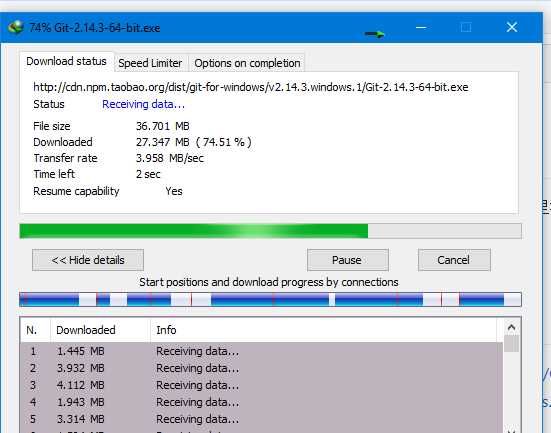
安装的时候, 建议选择这个, 会添加很多命令行工具:
nodejs: 去官网下载就行: https://nodejs.org/en/
正常安装即可. npm的版本不要低于5.0吧:

angular-cli, 官网: https://github.com/angular/angular-cli
npm install -g @angular/cli
visual studio code: https://code.visualstudio.com/
and visual studio 2017 of course.
建立angular项目
进入命令行在某个地方执行命令:
ng new client-panel
这就会建立一个client-panel文件夹, 里面是该项目的文件, 然后它会立即执行npm install命令(这里不要使用淘宝的cnpm进行安装, 有bug), 稍等一会就会结束.
使用vscode打开该目录, 然后在vscode里面打开terminal:
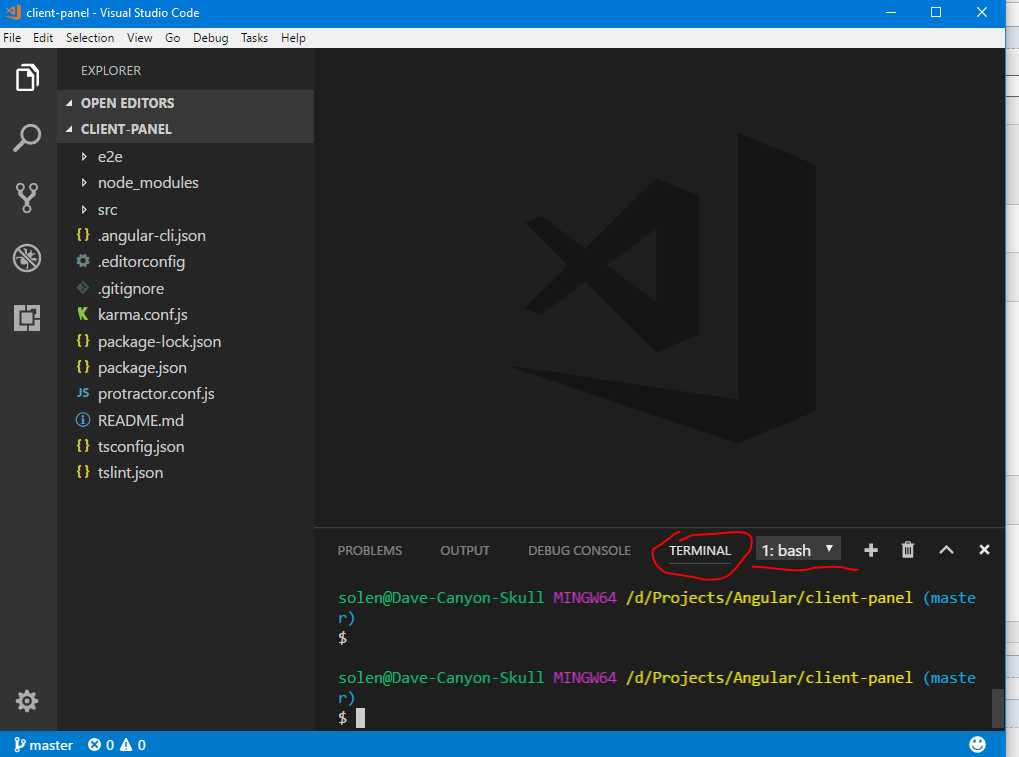
terminal默认的可能是powershell, 如果你感觉powershell有点慢的话, 可以换成bash(安装git时候带的)或者windows command line等.
第一次打开terminal的时候, vscode上方会提示你配置terminal, 这时就可以更换默认的terminal. 否则的话, 你可以点击菜单file-reference-settings, 自己选择一个terminal应用:
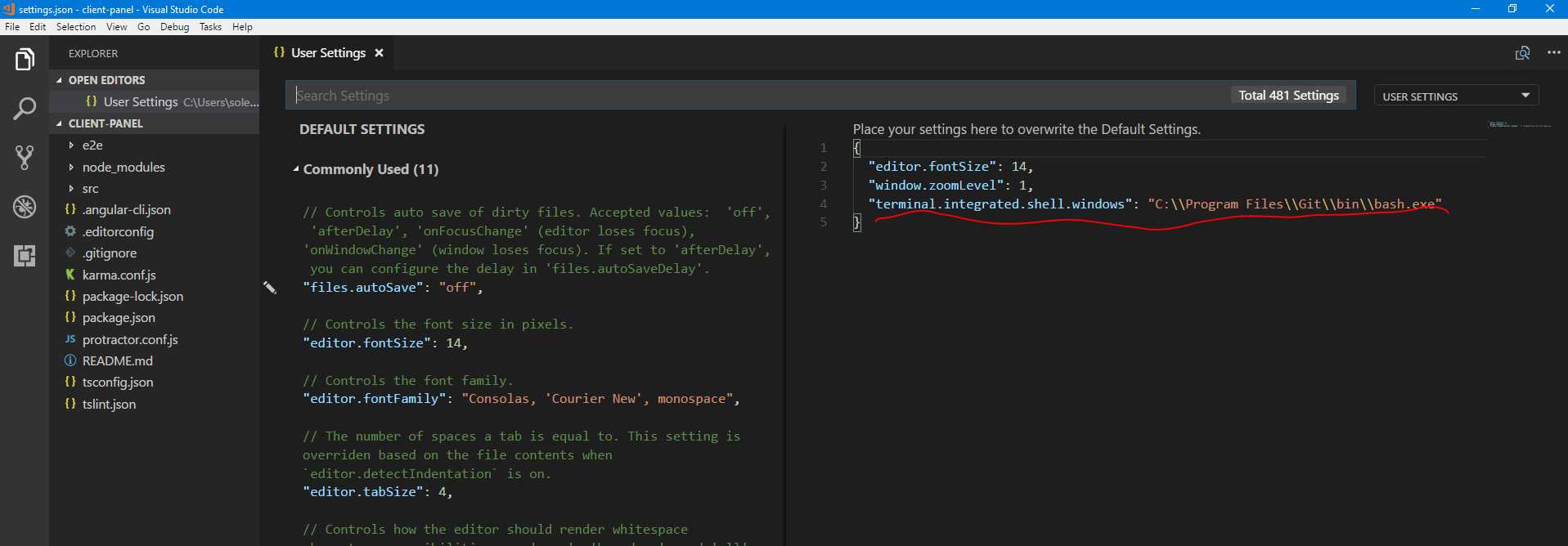
同样可以安装几个vscode的插件:
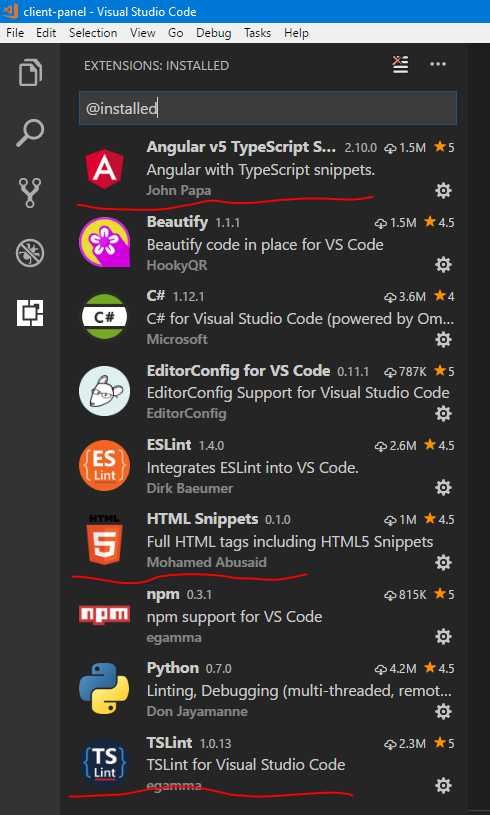
然后试运行一下项目, 在terminal执行 ng serve, 如果没问题的话, 大概是这样:

浏览器运行: http://localhost:4200
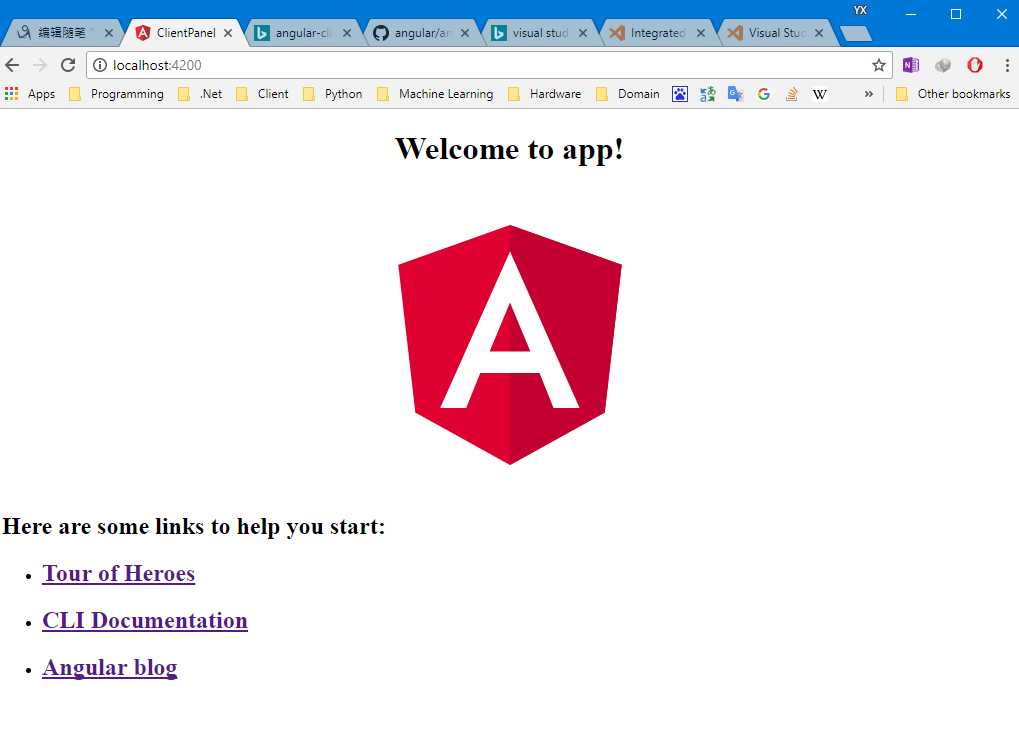
安装bootstrap4等:
安装bootstrap4, tether, jquery等:
npm install [email protected] tether jquery --save
安装成功后, 打开 .angular-cli.json, 把相关的css和js添加进去:
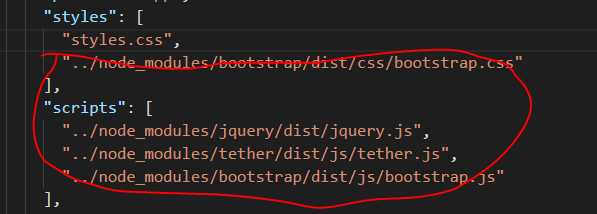
然后在运行试试 ng serve, 刷新:
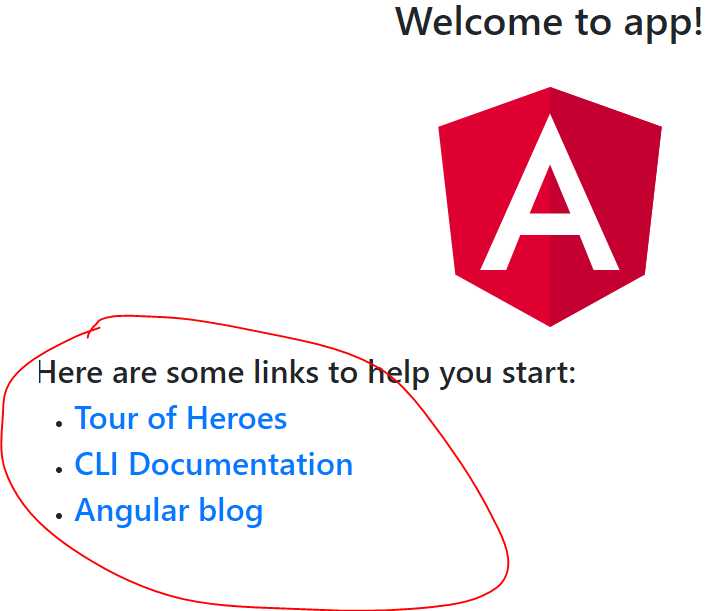
字体已经改变, bootstrap起作用了.
建立Components
建立dashboard:
terminal执行
ng g component components/dashboard
执行成功后会生成4个文件:
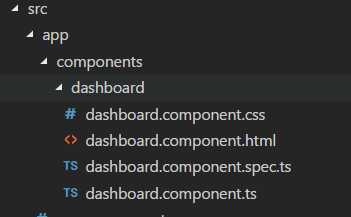
并且会自动在app.module.ts里面声明:
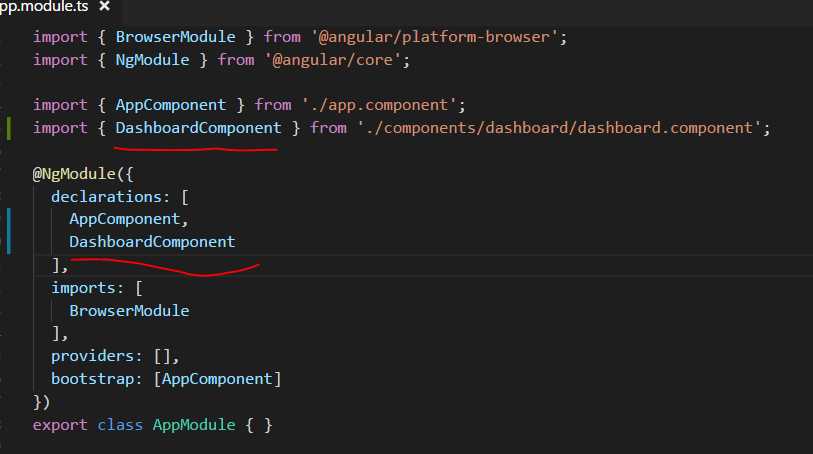
建立其他 components:
ng g component components/clients ng g component components/clientDetails ng g component components/addClient ng g component components/editClient ng g component components/navbar ng g component components/sidebar
ng g component components/login
ng g component components/register
ng g component components/settings
ng g component components/pageNotFound

建立Route路由
import { BrowserModule } from ‘@angular/platform-browser‘;
import { NgModule } from ‘@angular/core‘;
import { RouterModule, Routes } from ‘@angular/router‘;
import { AppComponent } from ‘./app.component‘;
import { DashboardComponent } from ‘./components/dashboard/dashboard.component‘;
import { ClientsComponent } from ‘./components/clients/clients.component‘;
import { ClientDetailsComponent } from ‘./components/client-details/client-details.component‘;
import { AddClientComponent } from ‘./components/add-client/add-client.component‘;
import { EditClientComponent } from ‘./components/edit-client/edit-client.component‘;
import { NavbarComponent } from ‘./components/navbar/navbar.component‘;
import { SidebarComponent } from ‘./components/sidebar/sidebar.component‘;
import { LoginComponent } from ‘./components/login/login.component‘;
import { RegisterComponent } from ‘./components/register/register.component‘;
import { SettingsComponent } from ‘./components/settings/settings.component‘;
import { PageNotFoundComponent } from ‘./components/page-not-found/page-not-found.component‘;
const appRoutes: Routes = [
{ path: ‘‘, component: DashboardComponent },
{ path: ‘register‘, component: RegisterComponent },
{ path: ‘login‘, component: LoginComponent }
];
@NgModule({
declarations: [
AppComponent,
DashboardComponent,
ClientsComponent,
ClientDetailsComponent,
AddClientComponent,
EditClientComponent,
NavbarComponent,
SidebarComponent,
LoginComponent,
RegisterComponent,
SettingsComponent,
PageNotFoundComponent
],
imports: [
BrowserModule,
RouterModule.forRoot(appRoutes)
],
providers: [],
bootstrap: [AppComponent]
})
export class AppModule { }
添加router-outlet:
打开app.component.html, 清空内容, 添加一个div(可以输入div.container然后按tab健):
<div class="container"> <router-outlet></router-outlet> </div>
现在刷新浏览器, 大约这样:
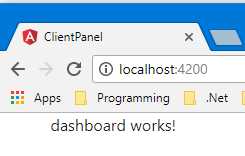
添加navbar:
修改navbar.component.html:
<nav class="navbar navbar-expand-md navbar-light bg-light"> <div class="container"> <a class="navbar-brand" href="#">Client Panel</a> <button class="navbar-toggler" type="button" data-toggle="collapse" data-target="#navbarsExampleDefault" aria-controls="navbarsExampleDefault" aria-expanded="false" aria-label="Toggle navigation"> <span class="navbar-toggler-icon"></span> </button> <div class="collapse navbar-collapse" id="navbarsExampleDefault"> <ul class="navbar-nav mr-auto"> <li class="nav-item"> <a class="nav-link" href="#" routerLink="/">Dashboard </a> </li> </ul> <ul class="navbar-nav ml-auto"> <li class="nav-item"> <a class="nav-link" href="#" routerLink="/register">Register </a> </li> <li class="nav-item"> <a class="nav-link" href="#" routerLink="/login">Login </a> </li> </ul> </div> </div> </nav>
修改app.component.html:
<app-navbar></app-navbar> <div class="container"> <router-outlet></router-outlet> </div>
运行:

建立Service
建立一个client.service:
ng g service services/client
然后在app.module.ts添加引用:
// Services Imports import { ClientService } from "./services/client.service";
并添加在providers里:
providers: [
ClientService
],
前端先暂时到这, 现在开始搞后端 web api.
建立asp.net core 2.0 的 Web api项目
web api项目源码: https://github.com/solenovex/asp.net-core-2.0-web-api-boilerplate
项目列表如图:
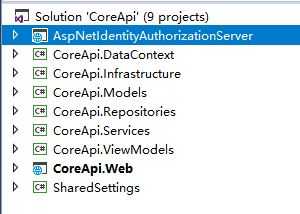
AspNetIdentityAuthorizationServer是一个单独的authorization server, 这里暂时还没用到, 它的端口是5000, 默认不启动.
CoreApi.Infrastructure 里面有一些基类和接口, 还放了一个公共的工具类等.
CoreApi.Models就是 models/entities
CoreApi.DataContext 里面就是DbContext相关的
CoreApi.Repositories 里面是Repositories
CoreApi.Services 里面就是各种services
CoreApi.ViewModels 里面就是各种ViewModels或者叫Dtos
CoreApi.Web是web启动项目.
SharedSettings是横跨authorization server和 web api的一些公共设置.
上面说的这些都没什么用, 下面开始建立Client的api.
建立Client Model(或者叫Entity)
在CoreApi.Models建立文件夹Angular, 然后建立Client.cs:
using CoreApi.Infrastructure.Features.Common; using Microsoft.EntityFrameworkCore; using Microsoft.EntityFrameworkCore.Metadata.Builders; namespace CoreApi.Models.Angular { public class Client : EntityBase { public decimal Balance { get; set; } public string Email { get; set; } public string FirstName { get; set; } public string LastName { get; set; } public string Phone { get; set; } } public class ClientConfiguration : EntityBaseConfiguration<Client> { public override void ConfigureDerived(EntityTypeBuilder<Client> builder) { builder.Property(x => x.Balance).HasColumnType("decimal(18,2)"); builder.Property(x => x.Email).IsRequired().HasMaxLength(100); builder.Property(x => x.FirstName).IsRequired().HasMaxLength(50); builder.Property(x => x.LastName).IsRequired().HasMaxLength(50); builder.Property(x => x.Phone).HasMaxLength(50); } } }
其中父类EntityBase里面含有一些通用属性,Id, CreateUser, UpdateUser, CreateTime, UpdateTime, LastAction, 这些是我公司做项目必须的, 你们随意.
下面ClientConfiguration是针对Client的fluent api配置类. 他的父类EntityBaseConfiguration实现了EF的IEntityTypeConfiguration接口, 并在父类里面针对EntityBase那些属性使用fluent api做了限制:
namespace CoreApi.Infrastructure.Features.Common { public abstract class EntityBaseConfiguration<T> : IEntityTypeConfiguration<T> where T : EntityBase { public virtual void Configure(EntityTypeBuilder<T> builder) { builder.HasKey(e => e.Id); builder.Property(x => x.CreateTime).IsRequired(); builder.Property(x => x.UpdateTime).IsRequired(); builder.Property(x => x.CreateUser).IsRequired().HasMaxLength(50); builder.Property(x => x.UpdateUser).IsRequired().HasMaxLength(50); builder.Property(x => x.LastAction).IsRequired().HasMaxLength(50); ConfigureDerived(builder); } public abstract void ConfigureDerived(EntityTypeBuilder<T> b); } }
弄完Model和它的配置之后, 就添加到DbContext里面. 打开CoreApi.DataContext的CoreContext, 添加Model和配置:
protected override void OnModelCreating(ModelBuilder modelBuilder) { base.OnModelCreating(modelBuilder); modelBuilder.HasDefaultSchema(AppSettings.DefaultSchema); modelBuilder.ApplyConfiguration(new UploadedFileConfiguration()); modelBuilder.ApplyConfiguration(new ClientConfiguration()); }
public DbSet<UploadedFile> UploadedFiles { get; set; } public DbSet<Client> Clients { get; set; }
然后建立ClientRepository
在CoreApi.Repositories里面建立Angular目录, 建立ClientRepository.cs:
namespace CoreApi.Repositories.Angular { public interface IClientRepository : IEntityBaseRepository<Client> { } public class ClientRepository : EntityBaseRepository<Client>, IClientRepository { public ClientRepository(IUnitOfWork unitOfWork) : base(unitOfWork) { } } }
图省事, 我把repository和它的interface放在一个文件了.
IEntityBaseRepository<T>定义了一些常用的方法:
namespace CoreApi.DataContext.Infrastructure { public interface IEntityBaseRepository<T> where T : class, IEntityBase, new() { IQueryable<T> All { get; } IQueryable<T> AllIncluding(params Expression<Func<T, object>>[] includeProperties); int Count(); Task<int> CountAsync(); T GetSingle(int id); Task<T> GetSingleAsync(int id); T GetSingle(Expression<Func<T, bool>> predicate); Task<T> GetSingleAsync(Expression<Func<T, bool>> predicate); T GetSingle(Expression<Func<T, bool>> predicate, params Expression<Func<T, object>>[] includeProperties); Task<T> GetSingleAsync(Expression<Func<T, bool>> predicate, params Expression<Func<T, object>>[] includeProperties); IQueryable<T> FindBy(Expression<Func<T, bool>> predicate); void Add(T entity); void Update(T entity); void Delete(T entity); void DeleteWhere(Expression<Func<T, bool>> predicate); void AddRange(IEnumerable<T> entities); void DeleteRange(IEnumerable<T> entities); void Attach(T entity); void AttachRange(IEnumerable<T> entities); void Detach(T entity); void DetachRange(IEnumerable<T> entities); void AttachAsModified(T entity); } }
EntityBaseRepository<T>是它的实现:
namespace CoreApi.DataContext.Infrastructure { public class EntityBaseRepository<T> : IEntityBaseRepository<T> where T : class, IEntityBase, new() { #region Properties protected CoreContext Context { get; } public EntityBaseRepository(IUnitOfWork unitOfWork) { Context = unitOfWork as CoreContext; } #endregion public virtual IQueryable<T> All => Context.Set<T>(); public virtual IQueryable<T> AllIncluding(params Expression<Func<T, object>>[] includeProperties) { IQueryable<T> query = Context.Set<T>(); foreach (var includeProperty in includeProperties) { query = query.Include(includeProperty); } return query; } public virtual int Count() { return Context.Set<T>().Count(); } public async Task<int> CountAsync() { return await Context.Set<T>().CountAsync(); } public T GetSingle(int id) { return Context.Set<T>().FirstOrDefault(x => x.Id == id); } public async Task<T> GetSingleAsync(int id) { return await Context.Set<T>().FirstOrDefaultAsync(x => x.Id == id); } public T GetSingle(Expression<Func<T, bool>> predicate) { return Context.Set<T>().FirstOrDefault(predicate); } public async Task<T> GetSingleAsync(Expression<Func<T, bool>> predicate) { return await Context.Set<T>().FirstOrDefaultAsync(predicate); } public T GetSingle(Expression<Func<T, bool>> predicate, params Expression<Func<T, object>>[] includeProperties) { IQueryable<T> query = Context.Set<T>(); foreach (var includeProperty in includeProperties) { query = query.Include(includeProperty); } return query.Where(predicate).FirstOrDefault(); } public async Task<T> GetSingleAsync(Expression<Func<T, bool>> predicate, params Expression<Func<T, object>>[] includeProperties) { IQueryable<T> query = Context.Set<T>(); foreach (var includeProperty in includeProperties) { query = query.Include(includeProperty); } return await query.Where(predicate).FirstOrDefaultAsync(); } public virtual IQueryable<T> FindBy(Expression<Func<T, bool>> predicate) { return Context.Set<T>().Where(predicate); } public virtual void Add(T entity) { Context.Set<T>().Add(entity); } public virtual void Update(T entity) { EntityEntry<T> dbEntityEntry = Context.Entry(entity); dbEntityEntry.State = EntityState.Modified; dbEntityEntry.Property(x => x.Id).IsModified = false; dbEntityEntry.Property(x => x.CreateUser).IsModified = false; dbEntityEntry.Property(x => x.CreateTime).IsModified = false; } public virtual void Delete(T entity) { Context.Set<T>().Remove(entity); } public virtual void AddRange(IEnumerable<T> entities) { Context.Set<T>().AddRange(entities); } public virtual void DeleteRange(IEnumerable<T> entities) { foreach (var entity in entities) { Context.Set<T>().Remove(entity); } } public virtual void DeleteWhere(Expression<Func<T, bool>> predicate) { IEnumerable<T> entities = Context.Set<T>().Where(predicate); foreach (var entity in entities) { Context.Entry<T>(entity).State = EntityState.Deleted; } } public void Attach(T entity) { Context.Set<T>().Attach(entity); } public void AttachRange(IEnumerable<T> entities) { foreach (var entity in entities) { Attach(entity); } } public void Detach(T entity) { Context.Entry<T>(entity).State = EntityState.Detached; } public void DetachRange(IEnumerable<T> entities) { foreach (var entity in entities) { Detach(entity); } } public void AttachAsModified(T entity) { Attach(entity); Update(entity); } } }
建立Client的ViewModels
在CoreApi.ViewModels建立Angular文件夹, 分别针对查询, 新增, 修改建立3个ViewModel(Dto):
ClientViewModel:
namespace CoreApi.ViewModels.Angular { public class ClientViewModel : EntityBase { public decimal Balance { get; set; } public string Email { get; set; } public string FirstName { get; set; } public string LastName { get; set; } public string Phone { get; set; } } }
ClientCreationViewModel:
namespace CoreApi.ViewModels.Angular { public class ClientCreationViewModel { public decimal Balance { get; set; } [Required] [MaxLength(100)] public string Email { get; set; } [Required] [MaxLength(50)] public string FirstName { get; set; } [Required] [MaxLength(50)] public string LastName { get; set; } [Required] [MaxLength(50)] public string Phone { get; set; } } }
ClientModificationViewModel:
namespace CoreApi.ViewModels.Angular { public class ClientModificationViewModel { public decimal Balance { get; set; } [Required] [MaxLength(100)] public string Email { get; set; } [Required] [MaxLength(50)] public string FirstName { get; set; } [Required] [MaxLength(50)] public string LastName { get; set; } [Required] [MaxLength(50)] public string Phone { get; set; } } }
配置AutoMapper
针对Client和它的Viewmodels, 分别从两个方向进行配置:
DomainToViewModelMappingProfile:
namespace CoreApi.Web.MyConfigurations { public class DomainToViewModelMappingProfile : Profile { public override string ProfileName => "DomainToViewModelMappings"; public DomainToViewModelMappingProfile() { CreateMap<UploadedFile, UploadedFileViewModel>(); CreateMap<Client, ClientViewModel>(); CreateMap<Client, ClientModificationViewModel>(); } } }
ViewModelToDomainMappingProfile:
namespace CoreApi.Web.MyConfigurations { public class ViewModelToDomainMappingProfile : Profile { public override string ProfileName => "ViewModelToDomainMappings"; public ViewModelToDomainMappingProfile() { CreateMap<UploadedFileViewModel, UploadedFile>(); CreateMap<ClientViewModel, Client>(); CreateMap<ClientCreationViewModel, Client>(); CreateMap<ClientModificationViewModel, Client>(); } } }
注册Repository的DI:
在web项目的StartUp.cs的ConfigureServices里面为ClientRepository注册DI:
services.AddScoped<IClientRepository, ClientRepository>();
建立Controller
在controllers目录建立Angular/ClientController.cs:
namespace CoreApi.Web.Controllers.Angular { [Route("api/[controller]")] public class ClientController : BaseController<ClientController> { private readonly IClientRepository _clientRepository; public ClientController(ICoreService<ClientController> coreService, IClientRepository clientRepository) : base(coreService) { _clientRepository = clientRepository; } [HttpGet] public async Task<IActionResult> GetAll() { var items = await _clientRepository.All.ToListAsync(); var results = Mapper.Map<IEnumerable<ClientViewModel>>(items); return Ok(results); } [HttpGet] [Route("{id}", Name = "GetClient")] public async Task<IActionResult> Get(int id) { var item = await _clientRepository.GetSingleAsync(id); if (item == null) { return NotFound(); } var result = Mapper.Map<ClientViewModel>(item); return Ok(result); } [HttpPost] public async Task<IActionResult> Post([FromBody] ClientCreationViewModel clientVm) { if (clientVm == null) { return BadRequest(); } if (!ModelState.IsValid) { return BadRequest(ModelState); } var newItem = Mapper.Map<Client>(clientVm); newItem.SetCreation(UserName); _clientRepository.Add(newItem); if (!await UnitOfWork.SaveAsync()) { return StatusCode(500, "保存客户时出错"); } var vm = Mapper.Map<ClientViewModel>(newItem); return CreatedAtRoute("GetClient", new { id = vm.Id }, vm); } [HttpPut("{id}")] public async Task<IActionResult> Put(int id, [FromBody] ClientModificationViewModel clientVm) { if (clientVm == null) { return BadRequest(); } if (!ModelState.IsValid) { return BadRequest(ModelState); } var dbItem = await _clientRepository.GetSingleAsync(id); if (dbItem == null) { return NotFound(); } Mapper.Map(clientVm, dbItem); dbItem.SetModification(UserName); _clientRepository.Update(dbItem); if (!await UnitOfWork.SaveAsync()) { return StatusCode(500, "保存客户时出错"); } return NoContent(); } [HttpPatch("{id}")] public async Task<IActionResult> Patch(int id, [FromBody] JsonPatchDocument<ClientModificationViewModel> patchDoc) { if (patchDoc == null) { return BadRequest(); } var dbItem = await _clientRepository.GetSingleAsync(id); if (dbItem == null) { return NotFound(); } var toPatchVm = Mapper.Map<ClientModificationViewModel>(dbItem); patchDoc.ApplyTo(toPatchVm, ModelState); TryValidateModel(toPatchVm); if (!ModelState.IsValid) { return BadRequest(ModelState); } Mapper.Map(toPatchVm, dbItem); if (!await UnitOfWork.SaveAsync()) { return StatusCode(500, "更新的时候出错"); } return NoContent(); } [HttpDelete("{id}")] public async Task<IActionResult> Delete(int id) { var model = await _clientRepository.GetSingleAsync(id); if (model == null) { return NotFound(); } _clientRepository.Delete(model); if (!await UnitOfWork.SaveAsync()) { return StatusCode(500, "删除的时候出错"); } return NoContent(); } } }
首先, Controller继承了ControllerBase这个类, ControllerBase是自己写的类, 里面可以放置一些公用的方法或属性, 目前里面的东西都没用:
namespace CoreApi.Web.Controllers.Bases { public abstract class BaseController<T> : Controller { protected readonly IUnitOfWork UnitOfWork; protected readonly ILogger<T> Logger; protected readonly IFileProvider FileProvider; protected readonly ICoreService<T> CoreService; protected BaseController(ICoreService<T> coreService) { CoreService = coreService; UnitOfWork = coreService.UnitOfWork; Logger = coreService.Logger; FileProvider = coreService.FileProvider; } #region Current Information protected DateTime Now => DateTime.Now; protected string UserName => User.Identity.Name ?? "Anonymous"; #endregion } }
由于父类构造函数依赖的类太多了, 所以我建立了一个CoreService, 里面包含着这些依赖, 然后用一个变量就注入进去了, 这种写法不一定正确:
public interface ICoreService<out T> : IDisposable { IUnitOfWork UnitOfWork { get; } ILogger<T> Logger { get; } IFileProvider FileProvider { get; } }
Controller里面的方法应该都能看明白吧. 需要提一下的是UnitOfWork.
Unit Of Work
我才用的是UnitOfWork和Repository模式, 多个Repository挂起的数据库操作, 可以使用一个UnitOfWork一次性提交.
由于DBContext已经实现了UnitOfWork模式, 所以可以直接在Controller里面使用DbContext, 但是我还是做了一个接口 IUnitOfWork:
namespace CoreApi.DataContext.Infrastructure { public interface IUnitOfWork: IDisposable { int SaveChanges(); int SaveChanges(bool acceptAllChangesOnSuccess); Task<int> SaveChangesAsync(bool acceptAllChangesOnSuccess, CancellationToken cancellationToken = default(CancellationToken)); Task<int> SaveChangesAsync(CancellationToken cancellationToken = default(CancellationToken)); bool Save(); bool Save(bool acceptAllChangesOnSuccess); Task<bool> SaveAsync(bool acceptAllChangesOnSuccess, CancellationToken cancellationToken = default(CancellationToken)); Task<bool> SaveAsync(CancellationToken cancellationToken = default(CancellationToken)); } }
里面前4个方法就是DbContext内置的方法, 后面4个方法可有可无, 就是上面4个方法的简单变形.
看一下CoreContext:
namespace CoreApi.DataContext.Core { public class CoreContext : DbContext, IUnitOfWork { public CoreContext(DbContextOptions<CoreContext> options) : base(options) { } protected override void OnModelCreating(ModelBuilder modelBuilder) { base.OnModelCreating(modelBuilder); modelBuilder.HasDefaultSchema(AppSettings.DefaultSchema); modelBuilder.ApplyConfiguration(new UploadedFileConfiguration()); modelBuilder.ApplyConfiguration(new ClientConfiguration()); } public DbSet<UploadedFile> UploadedFiles { get; set; } public DbSet<Client> Clients { get; set; } public bool Save() { return SaveChanges() >= 0; } public bool Save(bool acceptAllChangesOnSuccess) { return SaveChanges(acceptAllChangesOnSuccess) >= 0; } public async Task<bool> SaveAsync(bool acceptAllChangesOnSuccess, CancellationToken cancellationToken = default(CancellationToken)) { return await SaveChangesAsync(acceptAllChangesOnSuccess, cancellationToken) >= 0; } public async Task<bool> SaveAsync(CancellationToken cancellationToken = default(CancellationToken)) { return await SaveChangesAsync(cancellationToken) >= 0; } } }
差不多了, 开始
迁移数据库
在Package Manager Console分别执行 Add-Migration XXX和 Update-database命令.
注意这个时候 解决方案的启动项目必须是Web项目, 如果设置了多个启动项目, 迁移命令会不太好用.
然后运行一下: 选择CoreApi.Web而不是IISExpress, 这样的话端口应该是 http://localhost:5001/api/values
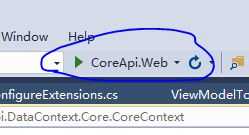
到Swagger里简单测试下
然后进入swagger简单测试一下ClientController: http://localhost:5001/swagger/
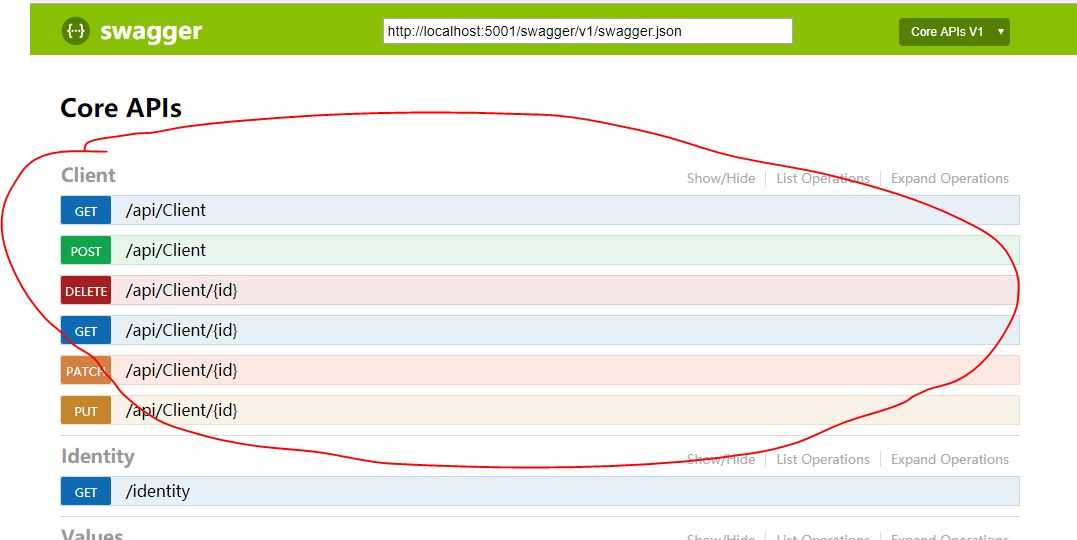
先添加数据 POST:
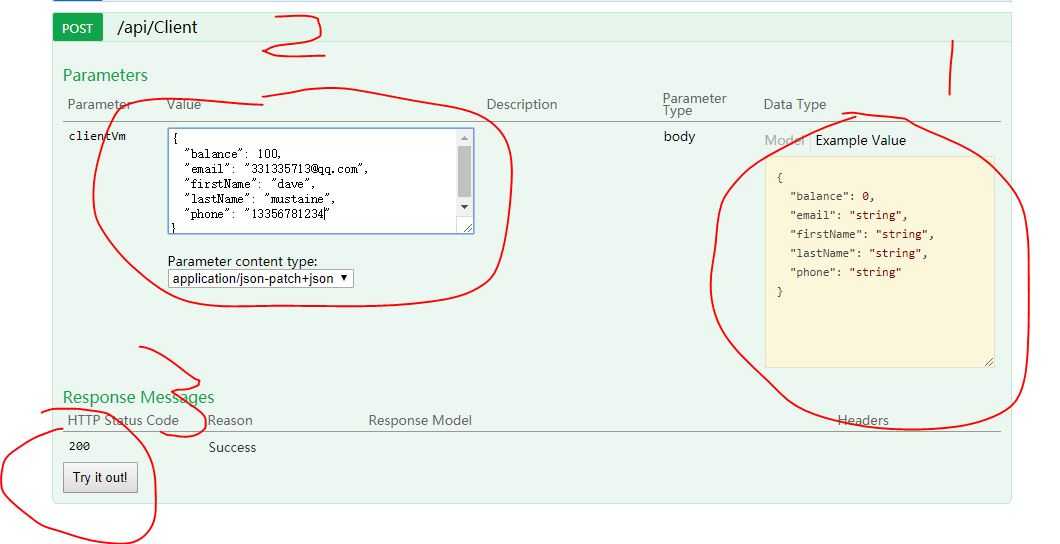
先点击右侧, 然后会把数据的json模板复制到左边的框里, 然后修改值, 然后点击try It out, 结果如下:
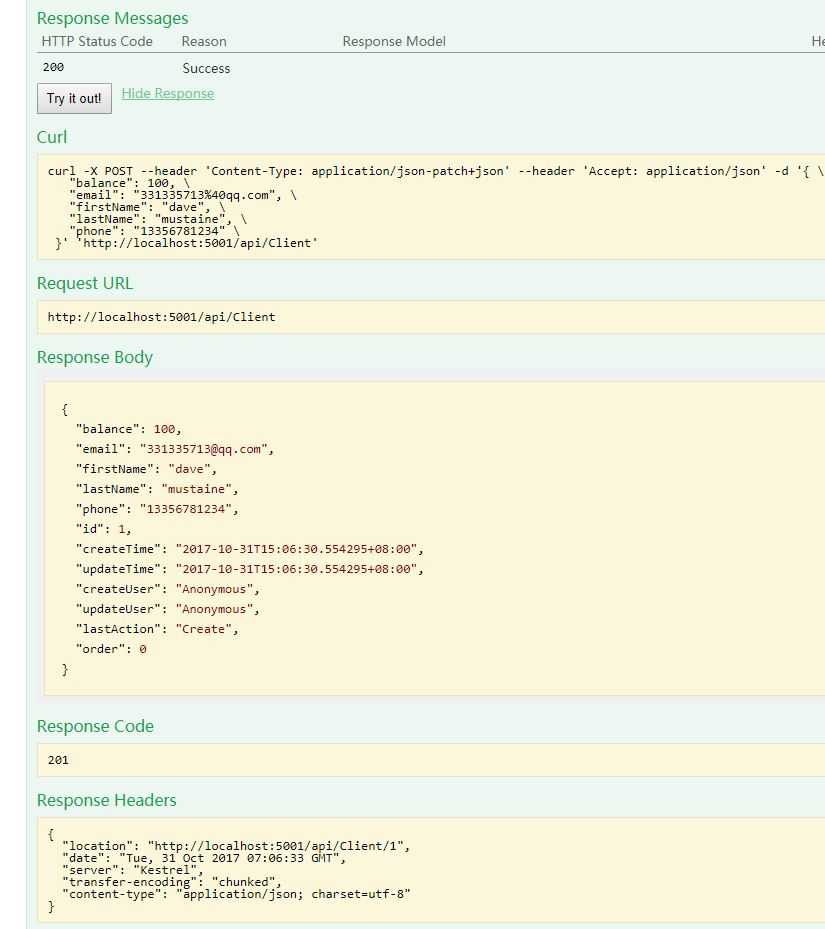
然后两个Get, Delete, Put您都应该会测试.
这里试一下 Patch:

再查询一下, 应该没有什么问题.
先写到这, 明天就能差不多写完了吧.
以上是关于使用angular4和asp.net core 2 web api做个练习项目的主要内容,如果未能解决你的问题,请参考以下文章
使用 Asp.net Core 诊断 Angular4 服务器端渲染的问题
Angular4 ASP.NET Core 1.2 Windows Authentication CORS for PUT 和 POST 给出 401
使用 Google Auth、Angular 4、ASP.Net Core 2 进行身份验证时出现 405
ASP.NET Core 2.1 API JWT 令牌 Session.id 在每次请求时都会更改
我无法在 asp.net core spas 中添加带有角度 cli 的新组件
这是如何使用 Entity Framework Core 和 ASP.NET Core MVC 2.2+ 和 3.0 创建数据传输对象 (DTO)
